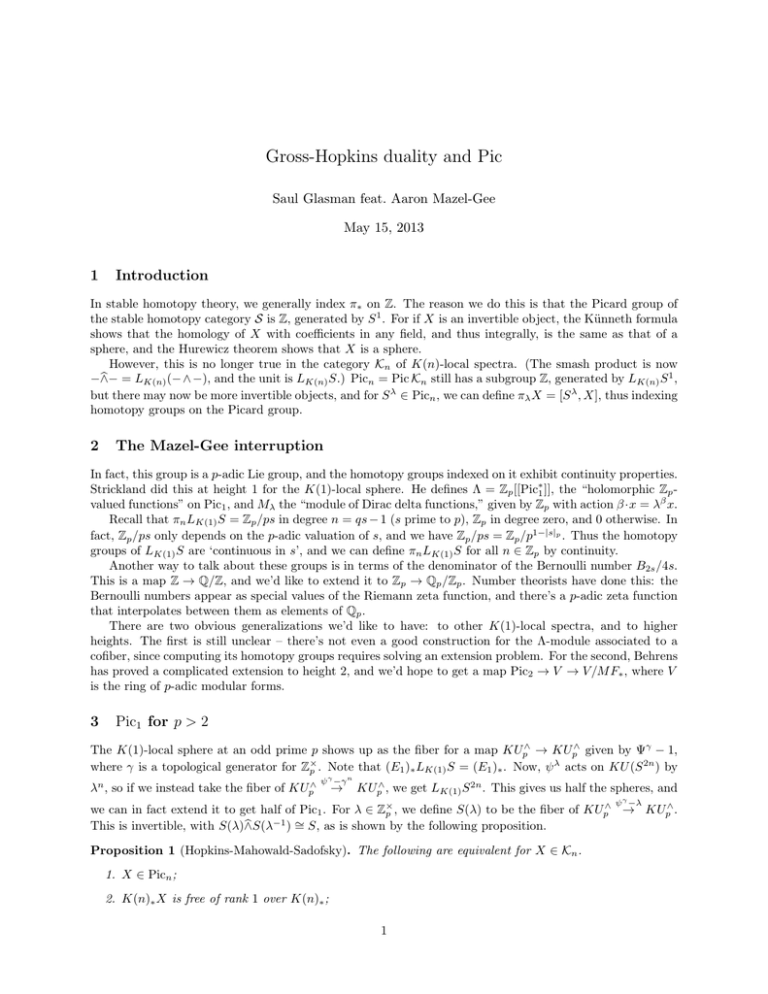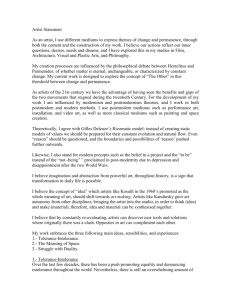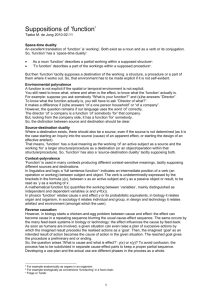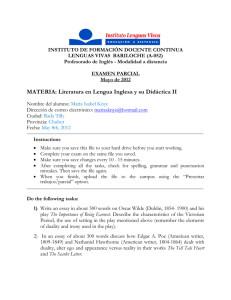Gross-Hopkins duality and Pic 1 Introduction Saul Glasman feat. Aaron Mazel-Gee
advertisement

Gross-Hopkins duality and Pic Saul Glasman feat. Aaron Mazel-Gee May 15, 2013 1 Introduction In stable homotopy theory, we generally index π∗ on Z. The reason we do this is that the Picard group of the stable homotopy category S is Z, generated by S 1 . For if X is an invertible object, the Künneth formula shows that the homology of X with coefficients in any field, and thus integrally, is the same as that of a sphere, and the Hurewicz theorem shows that X is a sphere. However, this is no longer true in the category Kn of K(n)-local spectra. (The smash product is now b − = LK(n) (− ∧ −), and the unit is LK(n) S.) Picn = Pic Kn still has a subgroup Z, generated by LK(n) S 1 , −∧ but there may now be more invertible objects, and for S λ ∈ Picn , we can define πλ X = [S λ , X], thus indexing homotopy groups on the Picard group. 2 The Mazel-Gee interruption In fact, this group is a p-adic Lie group, and the homotopy groups indexed on it exhibit continuity properties. Strickland did this at height 1 for the K(1)-local sphere. He defines Λ = Zp [[Pic∗1 ]], the “holomorphic Zp valued functions” on Pic1 , and Mλ the “module of Dirac delta functions,” given by Zp with action β ·x = λβ x. Recall that πn LK(1) S = Zp /ps in degree n = qs − 1 (s prime to p), Zp in degree zero, and 0 otherwise. In fact, Zp /ps only depends on the p-adic valuation of s, and we have Zp /ps = Zp /p1−|s|p . Thus the homotopy groups of LK(1) S are ‘continuous in s’, and we can define πn LK(1) S for all n ∈ Zp by continuity. Another way to talk about these groups is in terms of the denominator of the Bernoulli number B2s /4s. This is a map Z → Q/Z, and we’d like to extend it to Zp → Qp /Zp . Number theorists have done this: the Bernoulli numbers appear as special values of the Riemann zeta function, and there’s a p-adic zeta function that interpolates between them as elements of Qp . There are two obvious generalizations we’d like to have: to other K(1)-local spectra, and to higher heights. The first is still unclear – there’s not even a good construction for the Λ-module associated to a cofiber, since computing its homotopy groups requires solving an extension problem. For the second, Behrens has proved a complicated extension to height 2, and we’d hope to get a map Pic2 → V → V /M F∗ , where V is the ring of p-adic modular forms. 3 Pic1 for p > 2 The K(1)-local sphere at an odd prime p shows up as the fiber for a map KUp∧ → KUp∧ given by Ψγ − 1, λ 2n where γ is a topological generator for Z× p . Note that (E1 )∗ LK(1) S = (E1 )∗ . Now, ψ acts on KU (S ) by λn , so if we instead take the fiber of KUp∧ ψ γ −γ n → KUp∧ , we get LK(1) S 2n . This gives us half the spheres, and ψ γ −λ ∧ we can in fact extend it to get half of Pic1 . For λ ∈ Z× → KUp∧ . p , we define S(λ) to be the fiber of KUp −1 ∼ b S(λ ) = S, as is shown by the following proposition. This is invertible, with S(λ)∧ Proposition 1 (Hopkins-Mahowald-Sadofsky). The following are equivalent for X ∈ Kn . 1. X ∈ Picn ; 2. K(n)∗ X is free of rank 1 over K(n)∗ ; 1 2 3. (En )∧ ∗ X is free of rank 1 over (En )∗ . One can check that ψ γ acts by λ on (E1 )∧ ∗ S(λ), so that λ is uniquely determined by S(λ) (once we’ve fixed γ). Proposition 2 (Hopkins-Mahowald-Sadofsky). There’s a non-split extension 0 → Pic01 → Pic1 → Z/2 → 0, where Pic01 ∼ = Z× p is the group constructed above. ∼ Since Z× p = Z/(p − 1) ⊕ Zp and p is odd, the only way this extension can be non-split is if Pic1 = Z/(2(p − 1)) ⊕ Zp . In particular, there are torsion elements in the Picard group! We can exhibit a 2(p − 1)torsion element P as follows. If P = Σ−1 S(µ) is 2(p − 1)-torsion, then taking 2(p − 1)th smash powers gives √ S 2(p−1) = Σ2(p−1) P ∧(2(p−1)) = S(µ2(p−1) ). By construction, S 2(p−1) = S(γ p−1 ), so we must have µ = γ. This exists by Hensel’s lemma. In fact, we can define √ γ = ζ(p + 1) where ζ is a primitive (p − 1)th root of unity. Thus γ p−1 = (p − 1)p+1 , so we can take µ = p + 1. 4 Large primes Proposition 3 (Hopkins-Mahowald-Sadofsky). Suppose 2p − 2 > max(n2 , 2n + 2). Then the functor (En∧ )0 from Pic0n to the category of En -modules with Sn -action is injective. Sketch of proof. Let X ∈ ker((En∧ )0 ). We have an ANSS H ∗,∗ (Sn , (En )∧ ∗ (X)) ⇒ W (Fpn ) ⊗ Zp π∗ X, and by sparseness of the ANSS, this collapses. Its E2 term looks just like the E2 term for the sphere. There’s a class in E2 for the sphere corresponding to S → LK(n) S, which has to correspond in E2 for X to a map S → X. One checks that this gives X = LK(n) S. × One important En -Sn -module is det, the unreduced determinant. Sn = OD acts by linear maps on 2 D, which is a vector space of dimension n over Qp , giving a determinant map Sn → Z× p . The reduced determinant is the composition of this with the nth root map. 5 Brown-Comenetz duality The stable homotopy category has an obvious notion of duality given by Spanier-Whitehead duality. A second natural type of duality is given by Brown-Comenetz duality. For E and X spectra, the BrownComenetz dual of E is a spectrum IE such that (IE)n X ∼ = (E n X)∨ , where for A a locally compact ∨ 1 abelian group, A is its Pontryagin dual Hom(A, S ). In particular, πn IE ∼ = (π−n E)∨ . Brown showed ∼ this exists, and it in fact suffices to define it for the sphere, since we have IE = F (E, I), where I = IS. 2 Theorem 4 (Gross-Hopkins duality). LK(n) I ∈ Picn , and LK(n) I ∼ = Σn −n S(det) for p >> n. We also have LK(n) I ∼ = F (Mn S, I), allowing us to show that. 2 πt (Mn X)∨ ∼ = [X, LK(n) I]−t ∼ = [S n−n −t (− det), LK(n)DX] = πn−n2 −det −t LK(n) DX. In particular, this is a formula for the homotopy groups of the K(n)-local Spanier-Whitehead dual of X in terms of X, though we have to introduce this strange Picard element S(det) in order to do so. If pX = 0 mod p, then S(det) behaves like a “p-adic” sphere, which can be accessed by vn -periodicity. In the following case, we can replace this with an integral sphere. Theorem 5 (Gross-Hopkins). If F is a finite type n spectrum with pF = 0 with a vn -self map v of degree pm , then πt (F )∨ ∼ = πα−t LK(n) DF , where α= 2pnm (pn − 1) + n2 − n. p−1 6. THE MAZEL-GEE RESURRECTION 3 Gross-Hopkins duality can be thought of as a sort of Serre duality. If X si a smooth proper algebraic variety over a field k, F a coherent sheaf on X, and K is the canonical bundle on X, then Serre duality is an isomorphism H i (X; F )∨ ∼ = H n−i (X; K ⊗ F ∨ ). Replacing K with I, X with a K(n)-local space, cohomology with homotopy groups, the vector space duality on the left by Pontryagin duality, and the sheaf duality on the right with Spanier-Whitehead duality, we recover Gross-Hopkins duality. 2 Here are a few of the facts that go into this proof. First, LK(n) DEn ' Σ−n En , which one can prove via an ANSS. Second, Mn En ' Σ−n En /In∞ . Third, πt (En /In∞ ) ∼ = Ωn−1 (En )0 /Zpn ⊗(En )0 (En )−t , where Ω means the module of Kähler differentials. Combining these various isomorphisms gives us ∼ (En )∧ t I = πt (En ∧ LK(n) I) 2 ∼ = πt (Σn LK(n) DEn ∧ LK(n) I) ∼ = πt−n2 F (En , LK(n) I) ∼ = πn2 −t (Mn En )∨ ∼ πn2 +n−t (En /I ∞ ))∨ = n ∼ 2 = Ωn−1 (En )0 /Zpn ⊗(En )0 Et−n −n . ∼ ∼ ⊗n (det), which Gross and Hopkins prove using a lot of We need to prove that Ωn−1 (En )0 /Zpn = (En )2n (det) = ω rigid analytic geometry. 6 The Mazel-Gee resurrection Aaron said some things about the Gross-Hopkins proof and rigid analytic geometry far too fast for me to copy.







